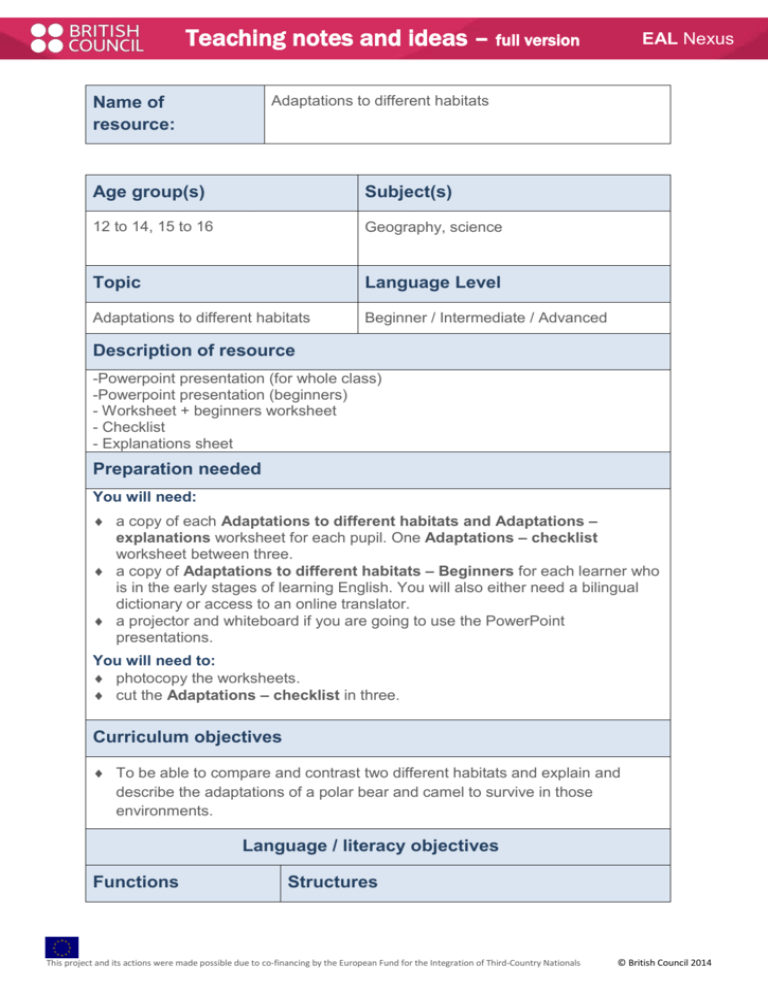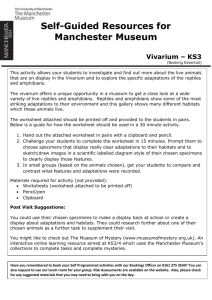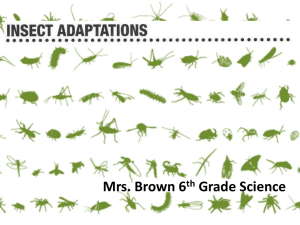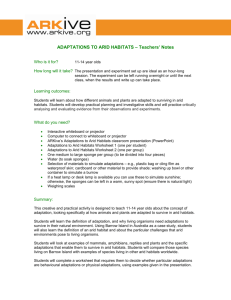Extended version - EAL Nexus
advertisement

Teaching notes and ideas – full version EAL Nexus Adaptations to different habitats Name of resource: Age group(s) Subject(s) 12 to 14, 15 to 16 Geography, science Topic Language Level Adaptations to different habitats Beginner / Intermediate / Advanced Description of resource -Powerpoint presentation (for whole class) -Powerpoint presentation (beginners) - Worksheet + beginners worksheet - Checklist - Explanations sheet Preparation needed You will need: a copy of each Adaptations to different habitats and Adaptations – explanations worksheet for each pupil. One Adaptations – checklist worksheet between three. a copy of Adaptations to different habitats – Beginners for each learner who is in the early stages of learning English. You will also either need a bilingual dictionary or access to an online translator. a projector and whiteboard if you are going to use the PowerPoint presentations. You will need to: photocopy the worksheets. cut the Adaptations – checklist in three. Curriculum objectives To be able to compare and contrast two different habitats and explain and describe the adaptations of a polar bear and camel to survive in those environments. Language / literacy objectives Functions Structures This project and its actions were made possible due to co-financing by the European Fund for the Integration of Third-Country Nationals © British Council 2014 EAL Nexus Comparing Explaining Justifying as well as similarly this is the same as also unlike this is different from however although this is because so that which because it needs to it needs … so that it can its… help it to it can … so that Vocabulary arid, cold, dry, dusty, extreme temperatures, freezing, frosty, harsh weather, hot, icy, monotonous, no trees, sandy, scorching snowy, sparse vegetation, bleak, bitterly cold, searing heat, parched, severe climatic conditions, glaring sunlight, desolate, blubber, hump This resource could be used: whole class as differentiation within class one to one or small group Ideas for using the resource What to do The Adaptations to different habitats – Beginners worksheet can be used as a differentiated activity in class or may be used as a one-to-one or small group lesson. Learners will need to have access to bilingual dictionaries either online or in book form and it may be easier to print out the PowerPoint slides if they are working alongside the whole class. Give out the Adaptations to different habitats worksheet to pupils and ask them to find as many similarities and differences between the Arctic and desert habitats as they can. The PowerPoint is designed as a way of introducing new vocabulary so deliberately contains some quite difficult words. Similarly, the beginners’ worksheet contains a list of words that are quite high level but that are needed for the topic. If there is no projector available, the words on the PowerPoint can be put on a whiteboard or the slide can be photocopied as a This project and its actions were made possible due to co-financing by the European Fund for the Integration of Third-Country Nationals © British Council 2014 EAL Nexus worksheet. Pupils could be asked to see how many different words they can think of before using the PowerPoint. Learners then work out the adaptations for the two animals and check the answers. The Beginners worksheet asks pupils to circle the correct answer whereas the rest of the class will need to write the list in their books. Next, learners work in pairs to try to work out why the animals have adapted as they have. This exploratory talk should help them complete the activity on the next sheet. If there are learners at the early stages of learning English in the class, this would be a good opportunity to place them with someone who speaks the same language so they can develop these ideas in the first language. Learners then complete the Adaptations – explanations worksheet by matching the adaptation to the correct phrase. The Beginners’ version is differentiated and is a substitution table so the answers (from the PowerPoint presentation) will need to be printed out if they are working with the whole class. Check the answers on the PowerPoint or orally if you do not have access to a projector and screen. The final task is for pupils to write about the habitats and the animals. The checklist has been included so that they can focus on using the specific vocabulary that has been introduced. It may be necessary to give further explanations for the words for comparing, contrasting and explaining to some pupils. They should be able to write a few paragraphs using some of the vocabulary that has been introduced. The Beginners’ task is differentiated here as they need to correct sentences. This may be enough for some learners but others may be able to go on to write some sentences independently. It is not necessary for learners to copy out the sentences particularly if they are going on to write their own. Other ideas for making the best use of this resource The checklist could be used for peer assessment. It allows for giving feedback in a constructive fashion because each target is very clear. Learners can then correct their own work based on the feedback. If the resource is being used in Key Stage 4 in Geography or Science, learners could be given a sample question from a GCSE paper rather than just writing some paragraphs. Possible extension activities Learners could research other habitats and animals that live there and write about the adaptations needed to survive. They could then work in pairs to produce a written comparison between their two chosen habitats. This project and its actions were made possible due to co-financing by the European Fund for the Integration of Third-Country Nationals © British Council 2014







